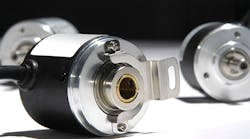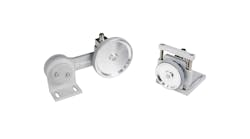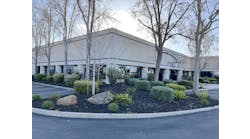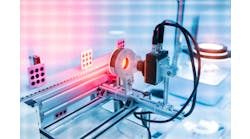In the world of automation and, specifically, controls design, the first lesson we all learn is that mistakes will get made. The key to all successful projects, whether for the home or office, is to learn from those mistakes so that past failures become the driving force through which we improve. If we don’t look back, we lose perspective. This loop of create, try, review and repeat the steps defines the creative loop. Each new discovery (lesson) becomes the defining point for the next step in the evolution of the product. The review and recalculate process is called closing the loop. Without this necessary step of making mistakes, we would never evolve. This same process can be applied to motion control.
One would be hard pressed to find a motion control solution these days that doesn’t involve closed loop control. To close the loop, a system receives a desired position (set value or SV), provides an output to a motive device (process value or PV) and then a sensor provides feedback from that device to determine the difference between the target position and the actual position. The system then modifies the output to close the gap between target and actual, until they are equal. Constant monitoring of the PV, comparing it to the SV and modifying the PV to gain parity defines the closed loop of motion control.
The method by which one measures the process value for motion can vary, but the two main methods providing positional feedback are resolvers and encoders. In purpose, the two methods are the same. We want to convert mechanical motion into an electrical signal. The techniques involved are closely attached to the theory of the electrical motor. A motor converts electric energy into mechanical energy, magnetism. The relationship between the induced magnetism and permanent magnets in close proximity causes rotation. For a conventional motor, the electricity is applied to windings in the stator (the stationary part of the motor) and the induced magnetism then interacts with permanent magnets in the rotor (the rotary part of the motor) causing the rotor to turn.
The key elements in a resolver are based on this same theory. The rotor, in this case, has the primary winding. Two secondary windings in the stator, sine (Sin) and cosine (COS), are phased 90-degrees apart mechanically. Applying an AC voltage to the primary winding in the rotor induces voltages in the secondary windings in the stator that are 90-degrees apart from one another. The voltage of the two windings are equal to the incoming reference voltage (on the primary) times the sine or cosine of the angle of the rotor from a zero starting point. The ratio of the sin and cosine voltages equals the absolute position of the shaft and a convertor changes the resolver value into a digital value to indicate the position of the shaft. The value produced is analog. The primary feature of a resolver is there is simply the relationship between the two induced voltages in the secondary windings. They are well-suited to harsh environments. Since there aren’t any electronics present, they can operate in higher temperature environments and are more robust.
An encoder, on the other hand, uses the same theory of a rotating shaft and a stationary sensing device but that is where the similarity ends. On the rotor are series of on and off segments spaced equally around the rotor. Successive bands have differing numbers of on and off segments. Sensors, mounted on the stationary part read the on and off segments and, from those states, one can determine the position of the rotating shaft. The on and off nature would suggest binary representation and this is mostly true. However, an encoder uses a reflected binary code (RBC).
Let’s look at reflected binary code for a moment. RBC, also known as Gray code after its inventor Frank Gray, is an ordering of the binary numeral system where two successive values differ by only 1 binary digit. In a normal binary sequence, 0000, 0001, 0010, 0011, 0100 would reflect the numbers 0, 1, 2, 3, and 4. Note how after the 0-1 transition, each successive count has at least two or more bits changing at any one time. The reason for using this method of counting is to eliminate the misinterpretation of a count value as the rotary shaft is moving. If we consider encoding using binary, no matter how precise the switching device, there is no way to guarantee that all bits in a sequence would switch at the exact same time. The result could put a count off by nearly as much as the entire count position. By using Gray code, the error during a bit change would result in only a very small deviation from the actual value.
For encoders, due to the accuracy of the technology and the rapid changing of bits representing the position of the rotating shaft, encoders have become favored for use in high-speed applications where rapid acceleration and deceleration occur. As the technology has improved, mechanical switches used to encode the position have been replaced by optical sensors. Optical sensors are contact-less and, thus, last much longer than mechanical switches. On the down side, optical encoders are more likely to be damaged due to an impact or severe vibration.
Resolvers have an accuracy of about 3 arcseconds whereas encoders have an accuracy of 20 arcseconds, a significant improvement. Encoders use lines on a disc to provide the counts on a 360-degree rotation. The more lines on the disc, the more resolute the encoder. As one can imagine, at some point, the number of lines on a disc get so close together that an accurate detection of light and dark becomes unreliable. For this reason, manufacturers of encoders will resort to interpolation to read the space between the lines to provide further resolution. The number of counts on the disc and the interpolation of those counts is commonly referred to as the counts per revolution (CPR) of the encoder. Typical resolution of an encoder would be 100 CPR, 200 CPR or 400 CPR, corresponding to the number of lines on the disc.
Further resolution can be made by use of quadrature output channels. Two channels, named A and B, with one of them shifted from the other by 90-degrees are employed by using a technique called quadrature multiplication. With this technique, we can get 1, 2 or 4 times the number of positions per resolution. To differentiate between the physical counts made internal to the encoder and those found through quadrature multiplication, the term pulses per revolution (PPR) is used to specify the count after the multiplication. With quadrature multiplication, a 400 CPR encoder would become a 1600 PPR encoder with 1600 pulses per 360-degrees being far more resolute than 400 counts per 360-degrees. All of this conversion happens on an encoder to counter chip that is external to the encoding device.
Further processing of the signal can take place outside of the encoder altogether. In the PLC or other processor, the encoder output can be scaled to account for gearing between the device the encoder is attached to and the normal cycle of the machine. This comes in handy where it might not be practical to mount the encoder directly to the main cycle shaft of a machine. An intermediate gear box output can be used to mount the encoder and then apply a gearing ratio to relate the motor driven shaft to the final motion cycle.
Considering all of the information reviewed above, it would seem that encoders provide a distinct advantage over using a resolver. To this end, most servo motors incorporate a high-resolution encoder, mounted directly to the shaft of the motor, to provide direct feedback to the control loop. One distinct advantage of the integrated encoder is the physical size of the motor allows for a much larger disc to be used to encode the position. Imagine, for example, 100 lines marked on a disc that is 1” in diameter. Those same 100 lines on a disc that is 4” in diameter would leave large empty spaces between the lines. It stands to reason that more lines can be marked on the disc and, when quadrature output is utilized, the quadrature multiplication would provide for much higher output resolution. For example, my favorite servo motor provides an effective feedback resolution of 262,144 cycles per revolution of the motor shaft.
However, as mentioned previously, some applications involve a harsh environment where temperature and vibration could render an optical device useless. No matter how resolute the encoder, if the optical device is damaged, the resolution would be zero. As with anything in our industry, technology is always improving. One would certainly believe there will come a day when an encoder is designed that can stand up to the rigors of high temperature and vibration. Until that day, there will be a place for a resolver in control design.






